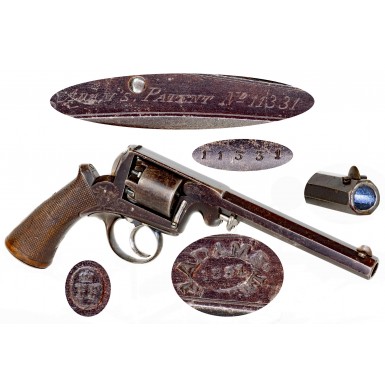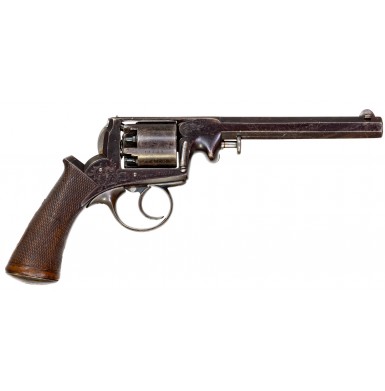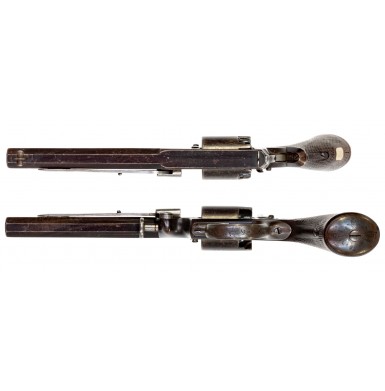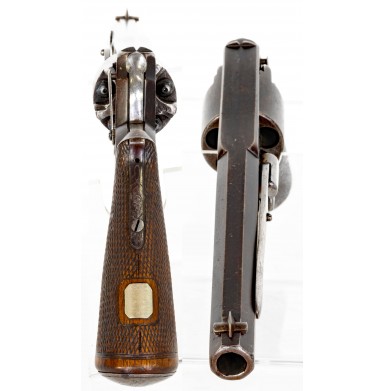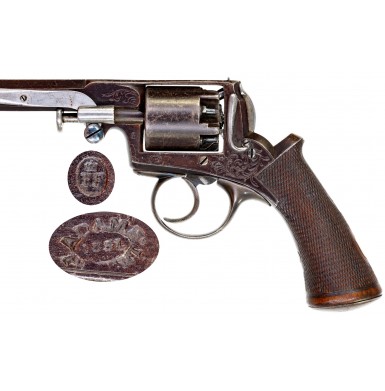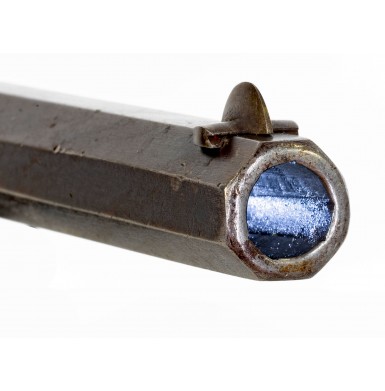Fine Belgian-made Adams 1851 Patent Revolver by Pirlot Freres
- Product Code: FHG-2423-SOLD
- Availability: Out Of Stock
-
$1,795.00
This is a very attractive example of a Belgian-made, licensed copy of an Adams’ Patent Model 1851 self-cocking (double action) revolver from the mid-1850s. These fine quality, solid frame revolvers were as important to the history and development of the revolving handgun as were the developments and designs of Samuel Colt. Robert Adams received his patent for a solid frame, one-piece revolver design in 1851. The patent covered his novel concept for a very strong revolver, where the frame and barrel were machined from a single steel forging. Unlike practically every other revolver design of the period, where the barrel and frame were separate components that were joined by wedges, screws, or some other mechanical system. Adams additionally patented a self-cocking lockwork, which today would be referred to as “double action only”. This mechanism cocked the hammer, rotated the cylinder, and released the hammer, all as the result of a single pull of the trigger. While this allowed for rapid fire, the long, heavy trigger pull inhibited accurate firing. These designs were incorporated into Adams Model 1851 self-cocking revolver. The major drawbacks to Adams’ Model 1851 design were the heavy double action only trigger and the lack of an integral loading lever, requiring lading tools to be transported with the gun if it needed to be reloaded while being carried. In 1854 Lt. Frederick Beaumont developed an improvement for Adams’ lockwork, which produced what would be called a traditional “double action” revolver today. The new lockwork allowed the revolver to operate in the fashion of Adams’ original design (double action), but also added the facility to cock the revolver manually and fire it with a lighter “single action” trigger pull. This refinement allowed for more accurate shooting. Interestingly the development still required the trigger to rotate and index the cylinder on most versions, unlike Colt’s design, which rotated the cylinder simultaneously with the cocking of the hammer. In 1854 Adams also patented refinements to his original frame design by adding a sliding frame mounted safety on the right side of the frame and an improved cylinder arbor retaining mechanism as well. The resultant combination of design improvements was manufactured as the Model 1854 revolver, known to most as the Beaumont-Adams revolver. The revolvers were produced directly by Adams as part of his partnership with the London based Deane, Adams & Deane (circa 1853-1855), as well under license by English gunmakers like Joseph Brazier and Isaac Hollis & Sons. Brazier and Hollis also produced frames under Adams’ license, which they subsequently provided to Adams for his company to build revolvers. Birmingham gunmaker William Tranter also employed Adams’ solid frame in the production of his revolvers but utilized lock works of his own design. Adams also licensed his design to gunmakers on the Continent, including Belgian makers in Liege and German makers in Prussia.
Upon the dissolution of the Deane, Adams & Deane firm, Adams went to work for the London Armoury Company, and his revolvers were produced there as well; both while he worked there from 1857-1858 and well into the production of the London Armoury made Kerr revolvers, circa 1860. Upon leaving the London Armoury Company, Adams went back to work producing his own revolvers, many of which were retailed by other London and Birmingham gun dealers and were often marked with the retailer’s name on the top strap. While most of the Beaumont-Adams revolvers were produced with loading levers designed by Adams, Joseph Rigby, or those patented by James Kerr (especially the guns manufactured by the London Armoury Company), a few were manufactured with a rather complex loading lever designed by Joseph Brazier.
When Adams licensed other makers to produce revolvers based upon his patents, he also assigned serial number ranges for them to work in. In England these serial numbers are typically followed with a suffix letter that indicates the manufacturer using the patent. For example, the letters “T” for Tranter, “B” for Brazier and “X” for Hollis & Sons were used to designate the maker of the gun. Those pistols produced by Adams himself are usually suffixed with an “R” or with no letter at all. On Beaumont-Adams revolvers a second number that had a “B” prefix was used to track the royalty payments due to Beaumont on his lock work patent. However, after the expiration of both patents, the guns are normally marked with only a single serial number and without any prefix or suffix letter. The Beaumont patent expired in early 1862, so these single serial number guns were most likely assembly after the expiration of his patent. Because Adams allocated serial number ranges to licensees who had the right to manufacture guns on his solid frame principle, it can be quite difficult to date Adams revolvers by serial number, especially prior to the expiration of the Beaumont patent. This is further complicated by the fact that sometimes Adams also produced guns in ranges that were previously allocated to other makers. According to English revolver authors & researchers W.H.J. Chamberlain and A.W.F. Taylerson, Brazier was allocated some numbers in the 30,000 B range prior to 1854, with the “B” suffix, while Adams himself produced revolvers in the same serial number range with an “R” suffix. They note that Hollis & Sheath never actually had their own serial number range but used their “X” suffix to distinguish their work, and that Adams often relied upon frames manufactured by William Tranter to manufacture his own revolvers! All of this clearly muddles the serial number picture for Adams handguns from about 1854-1860. From extant examples, however, it does appear that sometime in the mid-30,000 range serial numbers do become somewhat more consistent, and some inferences regarding dates of manufacture, attributed use, etc. can be drawn from the serial numbers of extant examples.
Adams followed a similar system of serial number allocation with the Liege makers that licensed his design in Belgium. The firms of Ancion & Cie, C Dandoy, Auguste Francotte and Pirlot Freres all acquired the rights to manufacture Adams patent revolvers in the early 1850s. Initially these were his model 1851 revolvers and like their English counterparts, were made without a loading lever. By the mid-1850s the makers were producing “transitional” guns which typically added a Kerr-style loading lever to the standard 1851 design. Within a year or two of the Model 1854 Beaumont-Adams being introduced, the Belgian makers shifted production to the more advanced design. Analyzing surviving examples of Belgian-made Adams revolvers suggests that some 10,000 to 11,000 guns had been made by these makers by the mid-1850s. The surviving serial numbers also indicate that Auguste Francotte was the most prolific of the Liege makers, producing close to 11,000 Adams revolvers of both patterns by the early 1860s. Pirlot Freres produced about half as many of the guns as Francotte, probably in the neighborhood of 6,000 guns during that period. Ancion & Cie appears to have only produced about 2,000 of the 1851 patent revolvers, both in the original form and transitional guns with Kerr patent ramrods and C Dandoy only produced about 1,100 of the guns, primarily standard Model 1851s with just a handful of transitional guns begin made with Kerr type levers.
This Belgian Licensed Model 1851 Adams Revolver remains in FINE condition. The revolver is a “transitional” gun that was probably produced circa 1855-1856 by the firm of Pirlot Freres. This firm produced Model 1851 Adams revolvers in the 8000-9900 serial number range, with transitional revolvers with Kerr-style loading levers beginning to be mixed into production in the 9900-12000 range. The produced more transitional revolvers in the 21000 to 22000 range and finally produced a small number of the 1854 Beaumont-Adams revolvers in the 20000-21000 range. This gun is serial number 11331 and falls in the early group of transitional revolvers produced prior to the adoption of the 1856 dated Adams patent marking.
The gun is a 54-Bore (nominally .442 caliber) handgun with a five-shot smooth round cylinder and a 6 ½” long octagonal barrel. The obverse frame is engraved in a single line arched below the cylinder:
ADAM’S PATENT No 11331
The Belgian-made guns did not include the letter suffixes found on the English-made guns to indication who the maker of the frame or gun was. The revolver is marked with a two-line arched cartouche on the lower front of the left side of the frame that reads ADAMS / PATENT, surrounding the date 1851. The front left of the frame is also marked with the {CROWN}/PF mark of Pirlot Freres. The firm of Pirlot Freres was formed as a partnership between brothers Eugene and Gustave around 1830. The firm was a member of the Liege arms makers trade consortium, the Societe Pour Les Armes de Guerre. The firm was so large that by 1856 they were having more that 40,000 gun barrels proved at the Liege proof house. The firm was also a major contractor for the Swiss military, producing large numbers of small arms for this important client. The firm went out of business in 1879 and was succeeded by the partnership of Pirlot & Fresard, who remained in business through 1890.
The matching serial number 11331 is found stamped on the side of the cylinder. The rear face of the cylinder is stamped with the typical Liege E/LG/* in an oval proof mark, as well as with assembly marks. There are no other markings, but the revolver does show simple, well-executed flowing foliate engraving at the lower rear of the frame and at the barrel web, forward of the cylinder. The revolver is finished with a lovely period brown finish with the hammer, 1851 patent Adams safety and the Kerr-style loading lever were left in the white. The trigger, percussion cones (nipples) and loading lever screw are fire blued. The octagonal barrel is 6 ½” in length and is rifled with three wide lands and grooves, that are roughly the same width. The bore rates about VERY GOOD+ and is mostly bright along its length but shows some moderate frosting and lightly scattered pitting in the grooves along its length as well.
As previously noted, the gun is in FINE overall condition and retains much of its original finish, probably retaining 85%+ coverage overall. The barrel retains about 90%+ of the original brown finish with moderate thinning and fading, with some noticeable loss and wear along the sharp edges of the barrel. The frame retains about 80%+ of its original finish with some more thinning and fading than the barrel. The two areas of largest loss on the frame are the triggerguard and backstrap, with the backstrap retaining about 50% thinning brown and the triggerguard retaining only traces. The cylinder retains about 60%+ of its original finish with thinning and scuffed wear responsible for much of the loss. The metal is almost entirely smooth throughout with some lightly scattered areas of minor surface oxidation, freckles of minor roughness and some small areas of pinpricking. The markings all remain clear and legible. The loading lever functions correctly and moves smoothly. The action of the revolver remains functional, and even the delicate and often broken 1851 pattern safety mechanism remains in place and functions as it should. Although functional, the trigger pull is both heavy and gritty and stacks substantially at the end of the pull, prior to releasing the hammer. The grittiness of the action suggests that maybe the gun has had some mechanical repairs in the past, a not uncommon issue with the somewhat complicated and delicate action. The front sight is a dovetailed round blade that appears to have been with the revolver for a very long time but is not typical of the front sight blades usually encountered on similar revolvers, suggesting it might be a very old, or even period of use replacement. The one-piece checkered walnut grip remains in about VERY GOOD+condition. The grip is solid, complete, and free of any breaks, cracks, or repairs. A lozenge shaped German silver escutcheon is mounted at the lower rear of the grip where an owner’s initials could be engraved. It remains blank. The grip does show wear and use with some moderate smoothing of the checkering and some scattered bumps, dings, and mars, most nobly on the obverse.
Overall, this is a really attractive, complete, and correct example of a Belgian-made “Brevete” Adams Patent 1851 Revolver by Pirlot Freres. This is a very nicely made example of a Belgian Adams revolver and shows the quality of the guns being made in Liege in the mid-19th century. While Francotte produced Adams revolvers appear on the market on a fairly regular basis, the Pirlot Freres-made guns are significantly less common. For any collector of European percussion revolvers, Adams revolvers or Belgian percussion revolvers, this would be a fine specimen to add to your collection. The gun is very attractive and even more attractively priced and is truly an example of a “lot of gun for the money.”
SOLD
Tags: Fine, Belgian, made, Adams, 1851, Patent, Revolver, by, Pirlot, Freres

